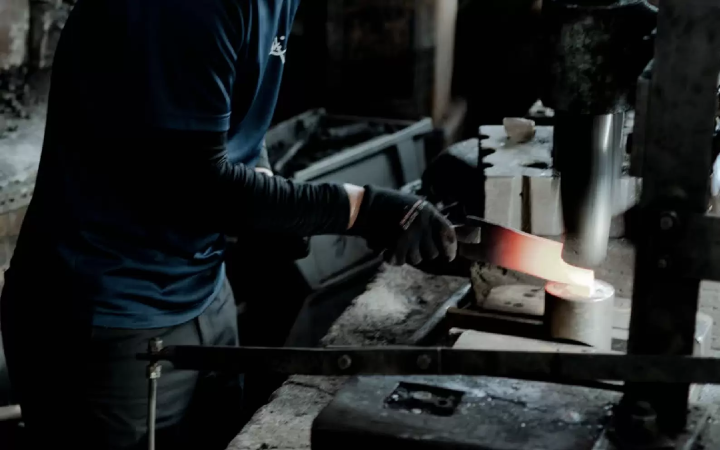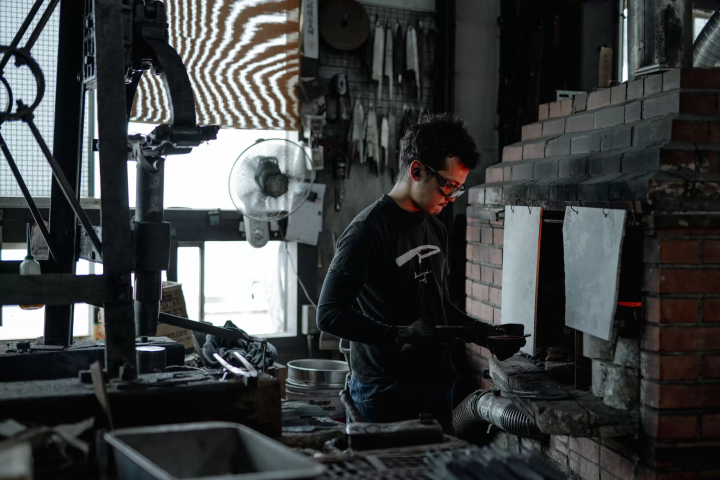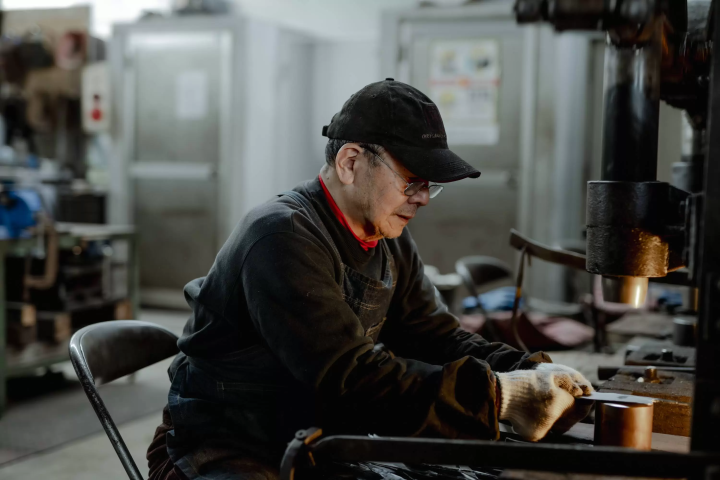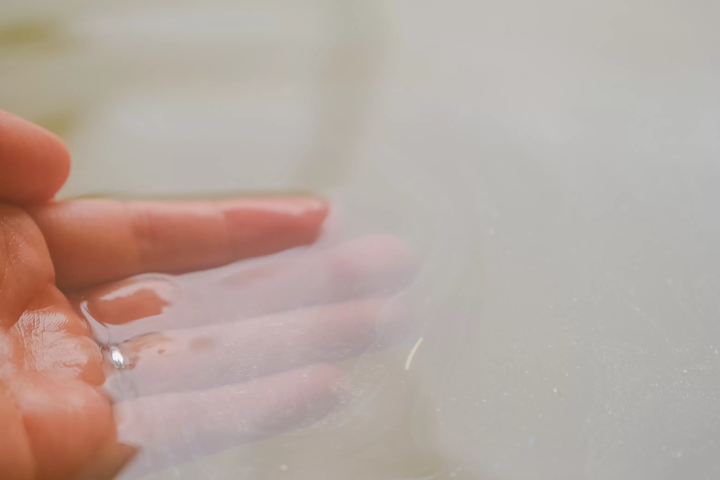"CRAFT TOURISM ECHIZEN" Towards a Land of Thousands of Years, A Craftsman's Desire Beginning with a Sword

・The story of Echizen cutlery that begins with a sword ・Swordsmith Chiyozuru Kuniyasu goes to Echizen ・Komainu with prayers for peace ・Goshintai as a talisman of the land, and a knife for living
historic process
The story of Echizen cutlery that begins with a sword
Among the traditional craft techniques that have been handed down in Echizen City for a long time, "Echizen Cutlery", which is represented by kitchen knives and sickles, boasts a history of over 700 years, and even today, craftsmen continue to train themselves every day.
There are roughly 14 processes for making knives. Forging lumps of steel and iron to make them strong, shaping them, firing them, striking them again, heating them, cooling them, and striking them again. And finally sharpen the blade. Although part of the process has been mechanized, the basic method of making it has not changed since 700 years ago.
Above all, there are two unique features in the process of making Echizen cutlery. These are the “double spread” for kitchen knives and the “mawashi steel attachment” for sickles and pruning shears.
“Two pieces of flattening” is a process in which two blades are placed on top of each other and struck from the front and back with a mallet so that the two blades spread thinly at the same time. By stacking two pieces, the thickness is doubled, and the strength is increased by compressing with a mallet.

"Mawashi steel attachment" is a method of forging the base iron and steel, and then crushing the entire blade into a diamond shape from one corner of the cutting edge. Compared to the general “flat method”, it is possible to make a sickle blade that is thinner and easier to sharpen.
The beginning of Echizen cutlery
Swordsmith Chiyozuru Kuniyasu goes to Echizen
The story of this Echizen cutlery begins when a swordsmith entered Echizen during the turbulent period of the Northern and Southern Courts, when Kamakura changed to Muromachi.
The year is 1337, and Chiyozuru Kuniyasu, a renowned swordsmith in Kyoto, was looking for a suitable land for making cutlery. After crossing the mountain pass, he entered Echizen Province, which was a production area of pure water and abundant iron, which are indispensable for the production of cutlery. One day, Kuniyasu was working on a "scythe" while making swords. The crescent moon suddenly reflected in the pond overlaps the shape of a sickle, and this is said to be the beginning of "Echizen sickle".
Normally, it is rare for swordsmiths to make sickles, and the fact that Kuniyasu has such legends may be proof that he was well integrated into the town of Fuchu.
In this way, Echizen, which has all three of the materials necessary for making knives, "water", "iron", and "fuel", became one of the best production areas in Japan due to the visit of a swordsmith named Kuniyasu. The technology is now recognized by
Takefu Knife Village, talks about the environment in Echizen.
“Considering that the water is so pure and high-quality iron can be mined, it makes sense. You can also get the pine charcoal that is used as fuel for forging. I wonder if he and his friends came to Echizen with him.
with a wish
Komainu with prayers for peace
When people hear the word “katana,” they imagine warfare. However, Chiyozuru Kuniyasu, as his name suggests, was a swordsmith who wished for peace and peace in the country more than anyone else.
At Chiyozuru Pond in the precincts of Chiyozuru Shrine in Kyomachi, there is a legend that every time Kuniyasu made a sword, he carved a whetstone to make a guardian dog and immersed it in the pond to make a wish. . Although Kuniyasu was a swordsmith, he is said to have worked under the belief that ``swords are not meant to kill people, but should be a symbol of the samurai.'' In fact, many komainu carved in stone have been found in the pond of the shrine.
At that time, Kuniyasu's swords were popular among samurai, and Tarotachi and Jirodachi used by Naotaka and Takamoto Megara of the Asakura family are famous. The names "Taro" and "Jiro" come from the fact that when samurai wielded two swords in those days, they called the longer one "Taro" and the shorter one "Jiro." Tarotachi is a large sword with a length of more than 2m, and although it is a sword large enough to be carried by several people, it is recorded in "Akechi Gunki" that Naotaka Megara was able to easily equip it by himself. there is
Standing inside the shrine, you can feel the back of Kuniyasu, who continued to make swords for warfare and delivered the Komainu. Mr. Kamo, who continues to cut knives, says that as a producer, he deeply sympathizes with Kokuan.
“We craftsmen often heard that Mr. Kuniyasu made a wish and submerged the Komainu in the pond. He must have been a very kind person. It may be that I felt stronger than anyone else that I shouldn't be in that kind of world."
from beginning to end of life
Goshintai as a talisman of the land, and a knife for living
After the Warring States period and the end of the samurai era, Kuniyasu's swords were also treasured as ``lucky charms that open up destiny'' and ``amulets to protect the land,'' and the figure itself became a sacred object. Atsuta-jingu Shrine now enshrines the great sword, and in 1932 it was also dedicated to Chiyozuru-jinja Shrine.
In addition, Echizen sickles, which Kuniyasu started, spread throughout the country by lacquer tappers in the late Edo period, and the name of Echizen cutlery became known to the world.
And now, Echizen's knives are highly evaluated worldwide, and knife craftsmen are flying around the world, including France, across the sea.

Echizen's "cutlery", which has changed in strength and flexibility to meet the needs of the times, is carefully forged one by one with the prayers and thoughts of each craftsman. It was the same as samurai training their minds and bodies by swinging their swords, but what they protect has also changed.

Once again, I recall the Komainu that Kuniyasu had submerged in the pond. Komainu are paired with an open mouth (“Agata” Agyo) and a closed mouth (“Ungyo” Ungyo). It seems that there is a meaning.
Thinking of the never-ending war, thinking of the people who spent their lives in the city of Echizen, Chiyozuru Kuniyasu made each sword with a prayer for peace. By touching the Echizen cutlery that has his roots, I would like you to think about the world we live in today.
(Synopsis)
5Chiyozuru Kuniyasu ⇒ Chiyozuru Pond/Komainu ⇒ Chiyozuru Shrine ⇒ Makara Jurozaemon "Taro Tachi/Jiro Tachi" A swordsmith who is said to have moved from Kyoto to Fuchu (now Echizen City) in search of
Kuniyasu is said to have originated Echizen sickles while making swords in Fuchu, Echizen. There is also a legend that Kuniyasu sank Komainu carved with a whetstone into Chiyozuru Pond with a wish.
In 1932, Chiyozuru Shrine was built on the shores of Chiyozuru Pond, with a sword that is said to have been made by the first Kuniyasuru Chiyozuru dedicated as an object of worship, in order to perpetuate Kuniyasu's exploits. In addition, the Odachi sword handed down at Atsuta Shrine is famous as a sword that is said to have been made by Kuniyasu. from beginning to end of life
▼Chiyozuru Shrine
https://chiyozuru.jimdofree.com/
▼ Takefu Knife Village
Echizen wisdom ~Proposing a new tourism, a journey of wisdom.~ A town that has inherited the skills and spirit of its predecessors for 1,500 years. Echizen, the entrance to the "Koshi no Kuni" ruled by an ancient king. A place of wisdom where cutting-edge technology and culture first flowed in from across the Sea of Japan and became the origin of Japan's profound manufacturing. In the traditional industries that coexist with the nature of the land and in the people who live here, the universal wisdom that human beings want to bring to the next 1000 years is alive. Here and now, there is a future born from exchanges that transcend national borders and time and space. A new quest to find light. Welcome to Echizen.
The contents on this page may partially contain automatic translation.




![[2025 Edition] A thorough guide to getting to the Echizen Great Buddha(Echizen Daibutsu)](https://resources.matcha-jp.com/resize/720x2000/2023/05/10-137958.webp)





























![[Wakayama Guide] Ume and Umeshu (Plum and Plum Wine)](https://resources.matcha-jp.com/resize/720x2000/2025/12/08-252248.webp)
![[2025 Update] From Kansai Airport to Namba - Recommended for travelers with large luggage! Travel comfortably by bus](https://resources.matcha-jp.com/resize/720x2000/2025/10/25-248088.webp)